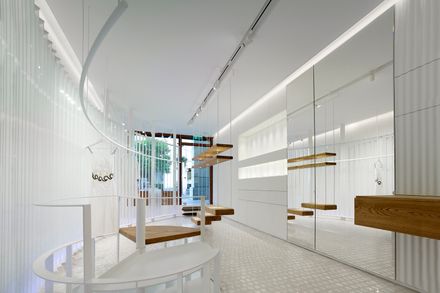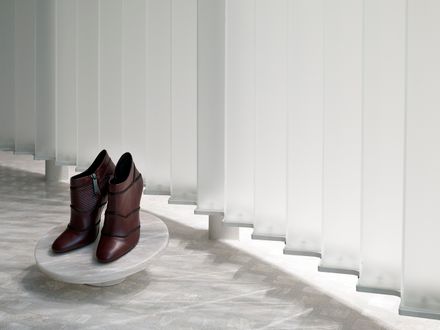
Zeus+Dione Store
ARCHITECTS
En Route Architects
LEAD ARCHITECTS
Katerina Kourkoula + Hannes Livers Gutberlet
MANUFACTURERS
Novamix, Autocad, Ioannou Cement, Luun, Nafpliotis Glass, Rhino, Xionas Metal Constructions
DESIGN TEAM
Katerina Kourkoula, Hannes Livers Gutberlet, Yiorgos Fiorentinos, Sofia Iatrou, Giorgos Nikopoulos
CONTRACTOR
Stepsis Ate
CLIENTS
Zeus+dione
PHOTOGRAPHS
Yiorgis Yerolymbos, Panagiotis Voumvakis
AREA
44 m²
YEAR
2019
LOCATION
Athens, Greece
CATEGORIES
Retail Interiors
The Zeus+Δione Flagship Store in Athens translates the inherent ability of fabrics to capture movement and light into static architectural space.
All surfaces are indirectly illuminated and appear to be hovering above the ground, thereby emphasizing a sense of lightness and transparency.
Through the placement of a floor-to-ceiling mirror on the backside wall, the perceived lightness is further complemented with an optical illusion of an infinitely extended space.
The design concept intends to not only mirror the values of Zeus+Δione as a brand but also to create a subtle and light backdrop for the presentation of seasonally changing garments and goods.
A subtle lightness could be achieved through a simple spatial layout and the transformation of locally allocated materials.
We initially approached the project by analyzing and reinterpreting aesthetic principles found in Greek antiquity.
Its principles could be briefly summarized as geometrically simple layouts dominated by repetitive arrays of structural supports.
On a detailed material level, the structural supports could then be interpreted as representations of fluid forms mimicking nature that are frozen in carved marble as ornaments and textures.
We hereby considered the pleated texture of undulated surfaces as a reoccurring topic that was equally present in ancient as well as modern Greek fashion.
From our analysis of Greek classical architecture and its material characteristics, we concluded that it admittedly transmitted timelessness and sophistication through geometric simplicity, material quality, and textured lightness.
The antique characteristics were thus the guiding principles for the design of the store.
The final layout was achieved with a simple geometrical gesture that wraps around seemingly floating surfaces.
A curved translucent divider creates spacious atmospheres on both sides, between spaces that need visual protection and the main shopping area.
The changing room and display vitrine are hereby still perceived as part of the main space, while the translucent surface of the glass divider allows for privacy, changing views, and interplays of shadow and light.
In addition, suspended, protruding, and recessed display surfaces complement the curvilinear glass divider at different moments throughout the store.
All surface materials were transformed, reinterpreted, and refined with state-of-the-art fabrication and developed in close collaboration with local manufacturers.
The wooden walls are undulated, the glass divider is pleated while the marble floor is embroidered. These elements thus embed a sense of plasticity that recalls the quality of architecture in Greek antiquity.
All surfaces are indirectly illuminated and appear to be hovering above the ground, thereby emphasizing a sense of lightness and transparency.
Through the placement of a floor-to-ceiling mirror on the backside wall, the perceived lightness is further complemented with an optical illusion of an infinitely extended space. A space that appears to be simultaneously calming and in constant flux.



























